I hate to do it to you, but Indiana Jones and the Great Circle is one of those games that is best described through the most cliche of mediums: comparisons to other games. It’s a strange alchemy of things we know from elsewhere, mashed together into a unique, new form. I sort-of love it.
First of all, this is an action game. Except it isn’t. Except it is. One of the key concepts behind this Indiana Jones adventure, explains creative director Axel Torvenius, is a subtle differentiation in genre: this is an Adventure-Action game – not an Action-Adventure game. The order in which the two genres appear is important, because it offers us a glimpse into the priorities of development. Indy is an action hero, of course – but he’s also an archaeologist and explorer.
When I think about this sort of thing, my mind is always drawn to James Bond – a spy, who sneaks, steals, and verbally spars as well as physically battles – but in his best video game outings, Bond has always basically been reduced to a more suave version of the Doom Guy. MachineGames may have made its name crafting high-octane shooters closely related to DOOM, but the studio obviously wanted to avoid giving Professor Jones a similar fate. So: Adventure-Action it is.
The Adventure plays out in a couple of different ways. First of all, there’s an adventure game element – that is to say, the genre. Every so often you’ll get the chance where things slow down and you’ll find Indy in some tomb or dusty old room with a puzzle to solve. There’s no action here – just your brain, the odd subtle bit of signposting, and environmental clues that tally along with Indy’s notebook, which gradually fills with mementos and information from his travels.
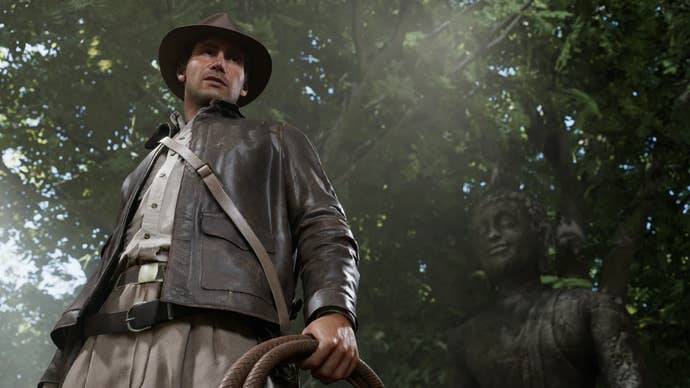
It’s these moments that I liked best, honestly. Simply exploring: not just tombs, but also the rest of the world MachineGames has crafted. In one more linear segment, you take control of Indy at Marshall College, the school where he teaches. This is a segment that lends towards the cinematic, part of the opening that sets up the game’s narrative. But time and care is taken to recreate the building, and to painstakingly nail details of both the 1936 setting and the 1981 film’s version of that time period. In the fashion of an adventure game or an immersive sim, notes and other pick-ups are dotted around, sure to keep completionist collectors busy while also filling in vital background and colour for the world and story.
Speaking of immersive sims, that’s the other genre that gets pulled upon. Another area shown at preview takes a different tack – rather than a linear A-to-B level, you’re given a wide open area to explore, in this instance around the Pyramids of Giza. This is where the experience comes into its own. There are story objectives you can make a beeline for, yes – but if you explore there are side dungeons, enemy encampments, and even towns to explore.
This setup dovetails nicely with where the hard-A Action does come into play – as the pyramids here are stalked by Nazi forces who recognize Indiana on sight and will attempt to take him down. What you get here is first-person brawling action. The trailers make clear that there’ll be a lot of fisticuffs, which is appropriate to the films – but what I didn’t expect was a sort of Hitman feel beyond that. Bullets are scarce, and melee weapons shatter and crumble after just a few hits on target. I found myself smashing an enemy, then quickly scouring the environment for the next thing – a trowel, a bottle of wine, a shovel, anything – to be ready for the next baddie.
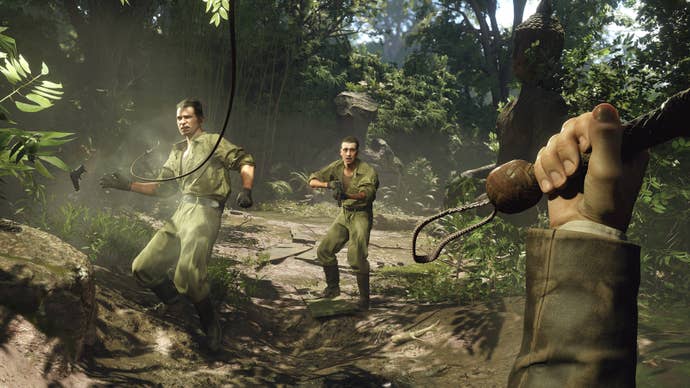
I expect some of the cadence of this combat won’t land as well for some – I can easily see it being lampooned as repetitive. But honestly, I was into it – the rhythm, the back-and-forth, and the fact it discourages you from being all-combat all the time – because that isn’t the sort of character Indiana Jones is.
There are guns too, of course – but ammunition is always limited. In a similar vein to Hitman, also, if you explore that Giza Pyramids open zone you can find costumes – don them and Indy will be able to avoid Nazi detection, making it easier to duck into little tombs and the like to tackle main story or optional side puzzle content.
“The way we got to the conclusion – it’s not easy,” says Torvenius of setting the game’s creative direction and balancing its different threads. “In the end, it was basically a pie chart,” he admits.
“That pie chart would say – okay, it should be this amount of hand-to-hand, maybe that amount of combat, that amount of set pieces, and this amount of platforming and sneaking, disguises, puzzles – you know? “We’d then try to balance that out to get the right sensation. Like, does this feel like you’d expect from Indiana Jones?”
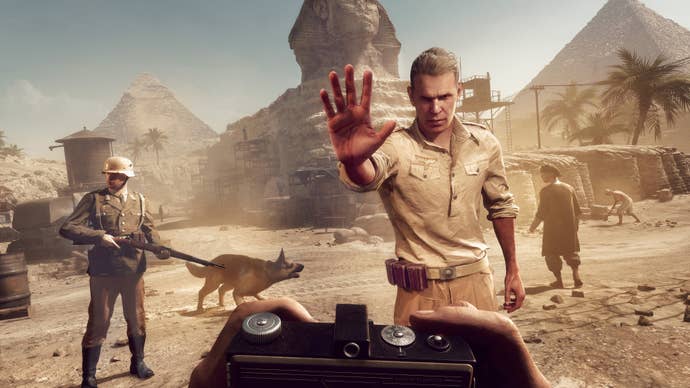
The answer, I think, is yes. There’s a lot of little touches that come together to make it happen, admittedly. The musical score, which appears to use interactive stems to react to the action, does a lot of heavy lifting, evoking John Williams’ classic work and making you really feel like the character. Troy Baker’s impression of Harrison Ford’s Indy is pretty bloody good, too – so those quips delivered as you smash a nazi over the head with a precious marble bust land well.
With that said, I do believe that most of it is simply down to the feel. The scrappiness of combat, the way you can do cool stuff like use the whip to drag an enemy to the floor or yank the weapon from their hand… When I grabbed a nazi by his lapels right close to a dangerous ledge and then punted him off it, down a distance that technically wouldn’t kill but would definitely incapacitate, it felt right. It felt like Spielberg wouldn’t be insulted.
It’s a funny thing, because you don’t really see Indy do that much sneaking in the films. Certainly James Bond, who I evoked earlier, does more. And yet in this context it feels right. Crucially, it’s optional – you can go in fists-first if you want – but I really began to enjoy the cadence and pace of stealthing around the Pyramids from puzzle-to-puzzle, only getting into the occasional scrap. That’s also the beauty of the combat, by the way – the best word to describe it is a scrap. There’s nothing so elegant about it as a battle – with Indy, it always feels vaguely like a bar fight, even when it’s taking place under a blazing Egyptian sun next to timeless monuments.
I have a sneaking suspicion that this won’t be for everyone. But honestly, I was really pleasantly surprised by the whole experience. It’s evocative of a bunch of things I love and have already name-checked – like Bond (one of Indy’s cinematic inspirations), like Hitman, but with a touch of Deus Ex rifling through the world and puzzles that feel like they could’ve been in a point-and-click adventure. These things come together to make it feel like Indiana Jones. There’s something else it feels like, though: a MachineGames joint.
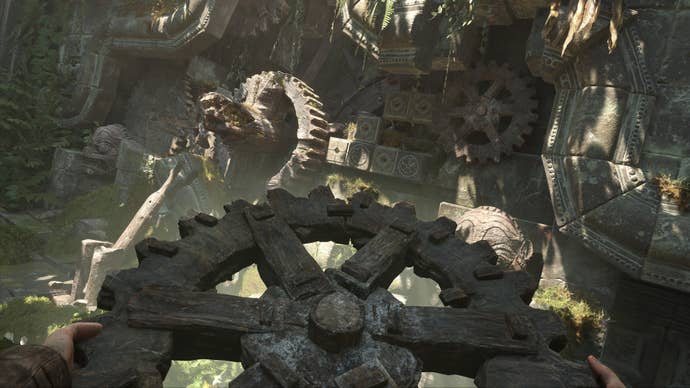
That feels weird to say, honestly, because I associate MachineGames with what I mentioned earlier – lashings of blood as you mow through hundreds of enemy soldiers, the meat grinder of an over-the-top war. It’s not very Indy. But that pacing is sort of flipped and twisted here – something that sounds wrong but feels rather right.
Instead of pressing ever onwards with ever-bigger guns, that sense of urgency turns into things like dashing past enemy patrols, or scrabbling around in the dirt for that next valuable melee weapon.
“We’ve really tried to make sure that we allow the game time to slow down,” notes Torvenius. “The pace can go slightly slower, but just because the pace goes down, it doesn’t mean that it gets boring. It’s quite the opposite.”
“There’s many sections throughout where – the pacing slows. Maybe there’s not an enemy to punch in the face, but it’s still high tension and super fun because you’re using your brain, solving a mystery, or trying to figure something out.”
The funny thing is, seeing that cadence written down in my transcription of my chat with Torvenius, another game franchise comes to mind: Indy’s gaming successor, one Lara Croft. But not her reboots, which followed in the footsteps of Nathan Drake – another Indy offshoot – but in the original games, with their vaguely stop-start nature of puzzling, then shooting a dinosaur or something, then puzzling, then downtime to explore, then dual pistols, and so on. Indiana is never quite going to whip out a couple of Browning Hi-Powers (though, you know, they were around in the appropriate era – so letting him use Lara’s gun would be a fun in-joke), but the cadence feels similar.
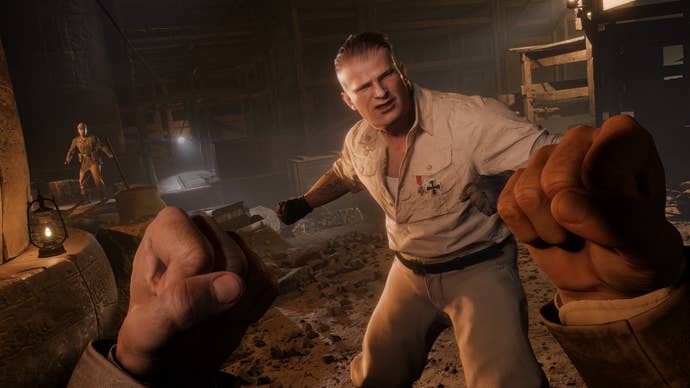
To some degree, as I let this thesis unfurl in my mind, I begin to see this game as a strange successor of sorts to those games – which is funny, as Lara was always pitched as Indy’s successor in the hot new form of storytelling that was video games. At the same time, it’s undoubtedly something original and new; a unique combination of familiar elements from elsewhere that nevertheless makes up an original and novel-tasting cocktail all its own.
“Those are fantastically good games, I love them,” Torvenius says of Uncharted and Tomb Raider, titles which will doubless cast some shadow in the direction of The Great Circle. “But when it comes to our position – we set out to create something very different to those games.”
“We’ve obviously been very aware that there will be similarities and comparisons, but for us it was never really an issue because the things that we very early on set out to do is so vastly different from those games.”
Much of that difference comes, I’d wager, in the Adventure. Like he said – it’s an Adventure-Action game. What I played scratched an itch I didn’t know I had – and I can’t wait to play the final release.
Indiana Jones and the Great Circle arrives on PC, Xbox, and Game Pass on December 9, and comes to PlayStation 5 in Spring 2025.
fbq('init', '1749355691872662');
fbq('track', 'PageView'); window.facebookPixelsDone = true;
window.dispatchEvent(new Event('BrockmanFacebookPixelsEnabled')); }
window.addEventListener('BrockmanTargetingCookiesAllowed', appendFacebookPixels);
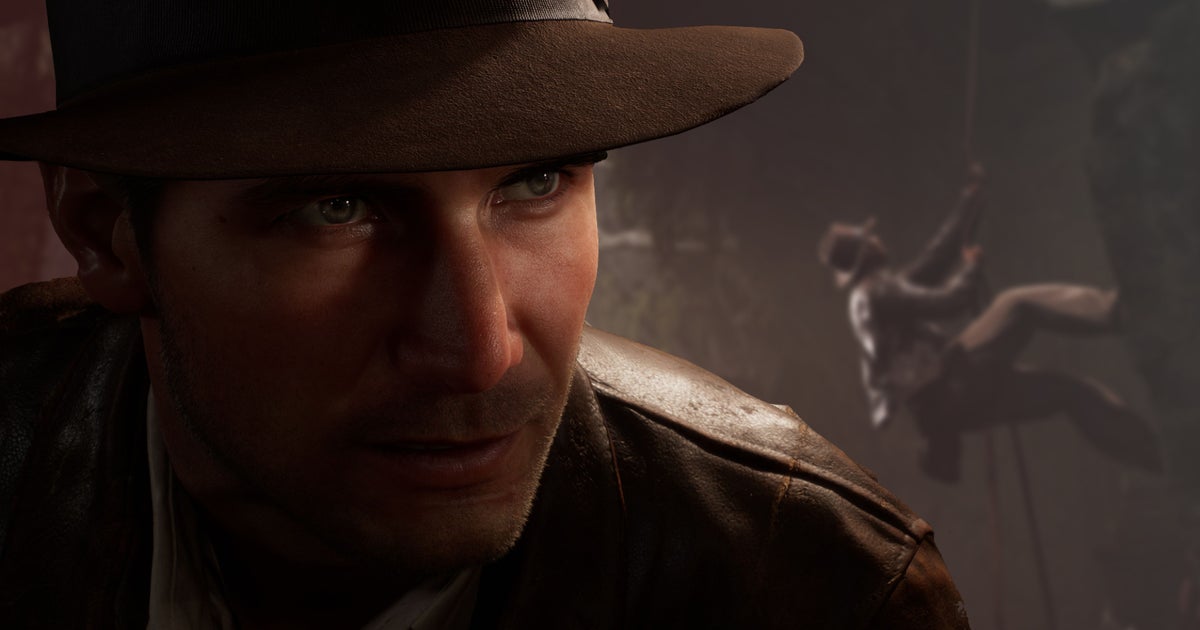

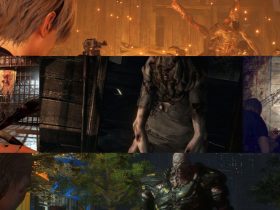

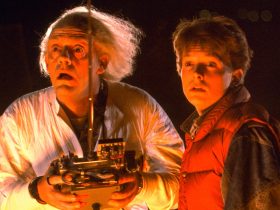
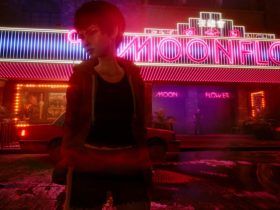


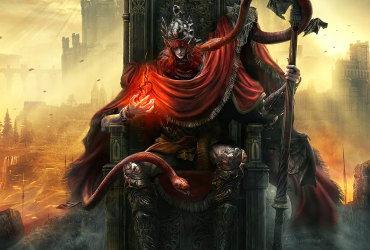

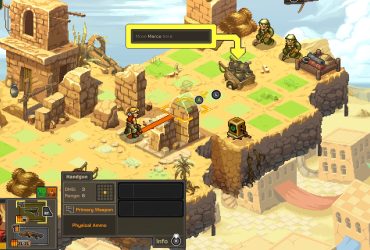
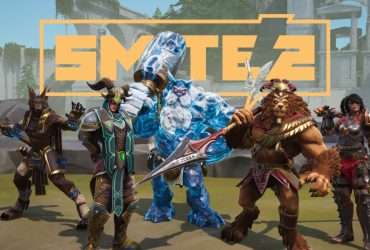
Leave a Reply